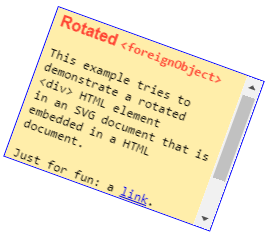The following example tries to demonstrate how a rotated
<div> can be embedded in an
SVG document, which itself is embedded in a
HTML document:

HTML source
This example was produced with the following source code:
<doctype HTML>
<html>
<head>
<title>Embedded HTML in SVG, embedded in HTML</title>
</head>
<body>
<svg
width ="290"
height="250"
>
<style>
foreignObject {
background-color: #fea;
border: 1px solid blue;
padding: 3px;
overflow: auto;
}
div {
font: 10px;
font-family: sans-serif;
height: 100%;
width: max-content;
margin: 4px;
}
b {
color: #f43;
}
</style>
<foreignObject
width="220"
height="160"
transform="translate(70 10) rotate(20)">
<div>
<b>Rotated <code><foreignObject></b><p>
This example tries to<br>
demonstrate a rotated<br>
<code><div></code> HTML element</br>
in an SVG document that is<br>
embedded in a HTML<br>
document.<p>
Just for fun: a <a href='javascript:alert("link was clicked")'>link</a>.<p>
And some more text so that<br>
the (vertical) scroll bar<br>
makes sense.
</div>
</foreignObject>
</svg>
</body>
</html>

